On January 18, 1930, Paul Gerhardt Sr. the Board of Education architect released plans for three schools to be built in the shadow of Riverview Amusement Park on a former clay pit on the southwest corner of Addison and Western in Chicago.
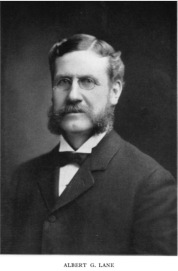 All three schools were to be named after Albert Grannis Lane, a renowned educator. There was to be the Lane Junior College, Lane Technical High School and the Lane Trade School. Due to the financial problems caused by the depression, only one building, the Albert G. Lane Technical High School was completed. In 2004 it was renamed to the Lane Technical College Preparatory High School.
All three schools were to be named after Albert Grannis Lane, a renowned educator. There was to be the Lane Junior College, Lane Technical High School and the Lane Trade School. Due to the financial problems caused by the depression, only one building, the Albert G. Lane Technical High School was completed. In 2004 it was renamed to the Lane Technical College Preparatory High School.
Please read on as we celebrate Albert, the early years of Lane Technical High School and the clay underneath
THE BEGINNING
His name was Albert Grannis Lane born March 15 1841 in the Gale Farm farmhouse somewhat northeast of Oak Park. He was the oldest of eight children, the son of Elisha Batchelder Lane 1815-1884, a carpenter, and Amanda Melvina Grannis 1821-1906. He married Francis M Smallwood 1844–1932, a schoolteacher.
Albert G. Lane earned an appointment to be principal of Franklin School just after leaving high school, becoming the youngest in the history of the Chicago Public Schools system. In 1869, Mr. Lane became Superintendent of the Cook County schools where he made many innovations to improve the quality of the public schools. He had a vision to create a large high school dedicated to providing students with hands-on experiences in technical education while developing and enhancing their academic skills.
THE “OLD” LANE
Albert’s first school opened in 1905 as the Thomas Hoyne Manual Training high school with 81 pupils
.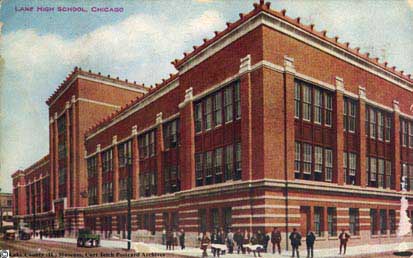 On Washington’s Birthday, February 22, 1909, the Albert Grannis Lane Manual Training High School opened at 1225 North Sedgwick Avenue at Division Street. Costing $765,523 it could only house 1600 students. Sadly, Albert never saw the opening of the new building.
On Washington’s Birthday, February 22, 1909, the Albert Grannis Lane Manual Training High School opened at 1225 North Sedgwick Avenue at Division Street. Costing $765,523 it could only house 1600 students. Sadly, Albert never saw the opening of the new building.
. By 1915, the students could take advantage of a wide array of technical and trade classes well beyond the regular academic subjects. A student could take carpentry, cabinet making, wood turning and joining. In the metal trades there was foundry, core making, molding, forge, and welding, There was a machine shop equipped with 80 machines and 60 lathes cast and built at Lane.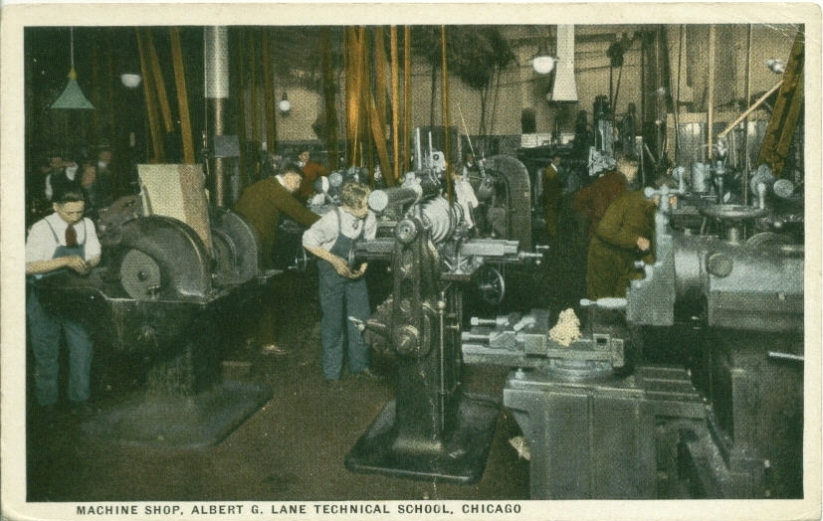

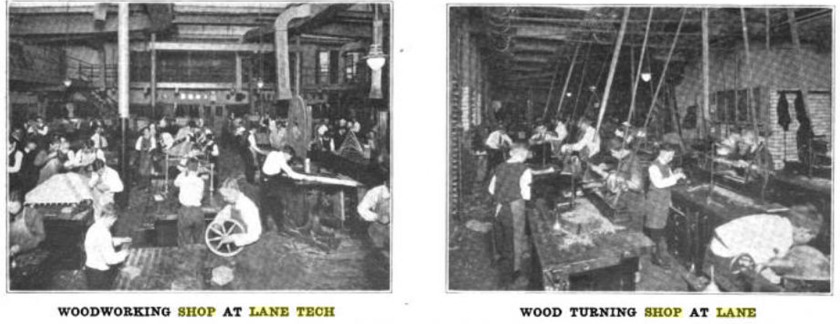

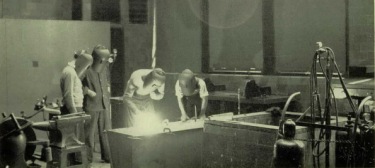

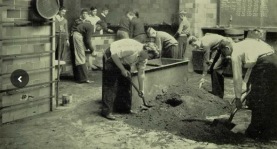 There was radio engineering to learn transmitters and electrical engineering where could students build motors, generators, transformers, and other instruments.
There was radio engineering to learn transmitters and electrical engineering where could students build motors, generators, transformers, and other instruments.
 There was a bake shop for breads and pastries where my Uncle learned a trade. Other classes included automotive shop, airplane construction, fundamentals of flying and a boat shop.
There was a bake shop for breads and pastries where my Uncle learned a trade. Other classes included automotive shop, airplane construction, fundamentals of flying and a boat shop. 
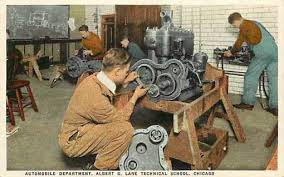
There was art, classical architecture, music, mechanical drawing as well as clubs for every interest.
The school song “Go Lane Go” was written by Jack T. Nelson, class of 1915 an assistant conductor of the Lane Orchestra, manager of the Glee Club and an accomplished musician.
A SERIOUS PROBLEM
By the 1930s, the “old” Lane had a student population of over 7,000 boys.  The Sedgwick building which held only 1600 was seriously overcrowded and thousands of overflow students were assigned to an Adams branch at 849 Townsend street, a Stockton Elementary school branch, the Beaubien Elementary school branch, three other branches, as well as five park fieldhouses, and 61 portable buildings. A new campus was sorely needed.
The Sedgwick building which held only 1600 was seriously overcrowded and thousands of overflow students were assigned to an Adams branch at 849 Townsend street, a Stockton Elementary school branch, the Beaubien Elementary school branch, three other branches, as well as five park fieldhouses, and 61 portable buildings. A new campus was sorely needed.
THE CLAY PIT
 There was this massive clay hole stretching from Riverview Amusement Park (originally Schuetzen Shooting Park) north to Addison Avenue and beyond. Chicago needed bricks in the decades after the Chicago fire to build thousands of houses and other buildings. The land bounded by Belmont, Western Avenue, the north branch of the Chicago river and on north toward Irving Park Road (then Graceland Avenue) was a massive clay deposit where several independently owned brickyards produced the classic Chicago brick until the clay was depleted. Weckler Brick Company and the William Birch brickyard were two that were formerly on land, now Lane. Also, according to the history of Lake View, Thurlow and Kuester brick company also worked the clay pit that is now the site of Lane.
There was this massive clay hole stretching from Riverview Amusement Park (originally Schuetzen Shooting Park) north to Addison Avenue and beyond. Chicago needed bricks in the decades after the Chicago fire to build thousands of houses and other buildings. The land bounded by Belmont, Western Avenue, the north branch of the Chicago river and on north toward Irving Park Road (then Graceland Avenue) was a massive clay deposit where several independently owned brickyards produced the classic Chicago brick until the clay was depleted. Weckler Brick Company and the William Birch brickyard were two that were formerly on land, now Lane. Also, according to the history of Lake View, Thurlow and Kuester brick company also worked the clay pit that is now the site of Lane.
The land was barren and inhospitable. Pollution from the brick kilns were a constant problem. A cattle feed lot at Addison (shown as Warner Avenue on one Sanborn map) and the river added to the miserable landscape. Back in 1892 a crudely built dam on the North Branch of the Chicago River built by the brickyard companies gave way and flooded a half square mile area. Houses had 5-6 feet of water. Six brickyards were submerged. Millions of bricks were destroyed. Even Sharpshooters park was under a foot of water.
Some years after the Sanborn map, many Chicago area brickyards were combined into the Illinois brick company. Even as late as 1930 Illinois Brick had three offices, one of which was the corner of Western and Roscoe.
. When the clay deposits were largely depleted the brickyards moved on to other areas. Ashes and refuse were used as fill then topped with a layer of topsoil to make the land saleable. After the brickyard era, it appears that Riverview then controlled the land for a time. Below is a Sanborn map that seems to indicate how Riverview’s property extended all the way north to Addison circa 1914 although no major rides or attractions were ever placed there. Riverview did sponsor a number of sports including baseball which might have been held in that area closer to Addison.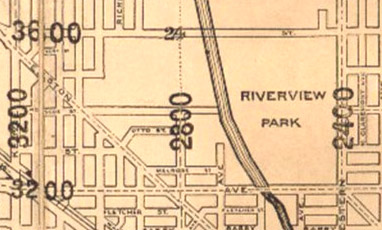
Below is a composite image that I made from combining two different vintage Sanborn fire maps and a 1930s era aerial photograph of the school .
.
The brick yards, south of Addison are shown in green. The brickyard on the southwest corner of Addison and Western was the Weckler brick company. Immediately south of it was the William Birch Brickyard.
South of the school is Sanborn’s mapping of Riverview Park. In the upper left corner of the map and just west of what would later be the Lane Tech stadium was the large circular Riverview’s Stadium Motordrome opened on July 8, 1911 costing $40,000, It had 30,000 seats but could hold 60,000 – 75,000 spectators. The entrance to the motordrome was at the north end of the Riverview picnic grounds. Sometime after 1911 when the motordrome closed, a new smaller 1/5 mile oval racetrack took its place. There are many photographs of race cars and their drivers who raced at either or both the oval racetrack and the motordrome.
The area shaded pink was the “Chicago Railways Co. Loop” and car barn. It was a turnaround and station for street cars bringing thousands of people into Riverview through its own broad entrance into Riverview, separate from the iconic main gate .
 As early as 1916, Addison and Western was being regarded as the future site of the school, despite the land noted as a city dump and an abandoned brickyard. Then in July 1923, the Mid City Golf and Amusement Company signed a 20 year lease from Illinois Brick. The 18 hole golf course opened July 4 1924 and occupied the land west of Western Avenue both north and south of Addison with a main entrance at Grace St.
As early as 1916, Addison and Western was being regarded as the future site of the school, despite the land noted as a city dump and an abandoned brickyard. Then in July 1923, the Mid City Golf and Amusement Company signed a 20 year lease from Illinois Brick. The 18 hole golf course opened July 4 1924 and occupied the land west of Western Avenue both north and south of Addison with a main entrance at Grace St.
On April 9 1926 it was finally recommended that the Chicago Board of Education purchase the 30 acres property south of Addison “now used as a golf course”, a “filled in clay hole”. The land cost was $510,000 ($17000 per acre) and initial building plans were announced in September of 1927.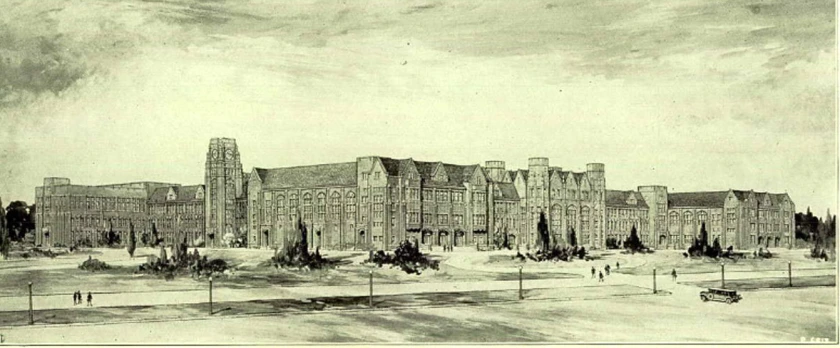 On January 18, 1930, Paul Gerhardt Sr. the Board of Education architect drew up plans for three schools but due to the depression, only one building, the Albert G. Lane Technical High School would prevail. Ground was broken in July of 1930. At the time they envisioned the largest gymnasium to be available for “convention purposes” and as an “industrial exhibit hall”. The auditorium wouls serve public functions.
On January 18, 1930, Paul Gerhardt Sr. the Board of Education architect drew up plans for three schools but due to the depression, only one building, the Albert G. Lane Technical High School would prevail. Ground was broken in July of 1930. At the time they envisioned the largest gymnasium to be available for “convention purposes” and as an “industrial exhibit hall”. The auditorium wouls serve public functions.
In 1931 there were mass meetings to defeat the plan to name the high school, Thomas A Edison. That plan failed and the cornerstone was laid on June 2, 1931. A lack of Finances stopped the project and work did not resume until January of 1934. Partially completed walls resting on piles sunk 85 feet which sat unprotected had begun to deteriorate.
Below is the aerial photo taken in the 1930s, not long after Lane was built, which shows both the school as well as the golf course still existing north of Addison Av..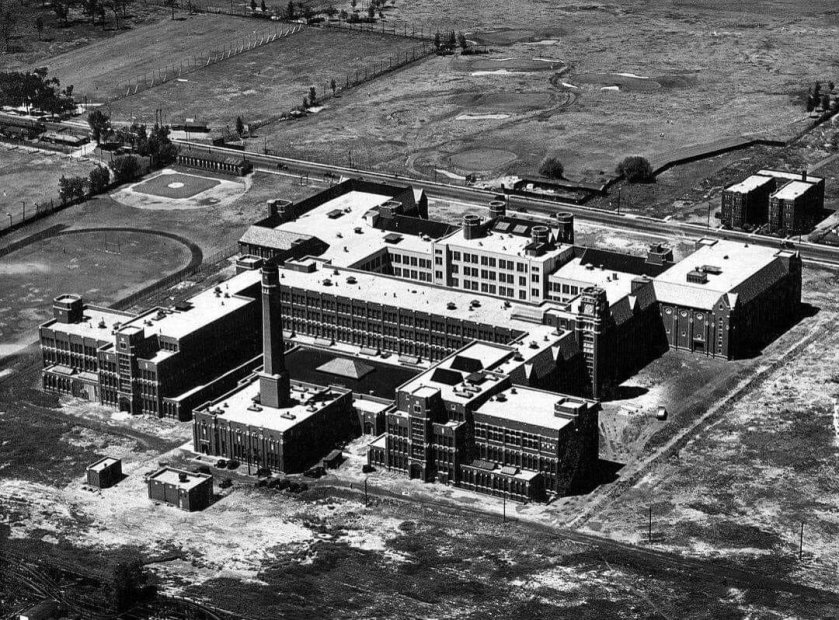
DEDICATION
On September 17, 1934, at 2501 W. Addison, the new $6 million dollar building designed by the then school architect John C. Christensen was finally dedicated. Over 9,000 boys and faculty gathered at Wrigley Field and then walked west to the new 30 acre campus. The dedication was broadcast over WGN radio and the school name was changed to the Albert Grannis Lane Technical High School to reflect the school’s expanding curriculum. To many of us it was simply “Lane Tech.”
After the dedication, the Sept 18 1934 Chicago Tribune reported:
“In a cheerful dining room seating 360 persons, officials, teachers, and others sat at flower decorated tables and were served a luncheon from model kitchens. The Mayor (Kelly) ate heartily of macaroni and cheese.”
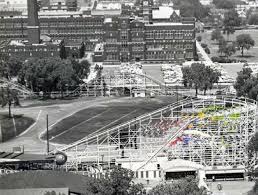 The new building in the shadow of Riverview was immense. Newspaper reports touted 607,000 square feet of space, 300 faculty & staff, 1-1/2 miles of corridors and 20 stairwells. There were 65 classrooms, 45 shops, 22 washrooms, 20 laboratories for chemistry biology physics and general science, 16 mechanical drawing rooms, 5 architect drawing rooms, 2 music rooms, 5 art rooms, 4 gymnasiums, a swimming pool, a beautiful library, an auditorium seating 2300, a cafeteria that could seat 1150.
The new building in the shadow of Riverview was immense. Newspaper reports touted 607,000 square feet of space, 300 faculty & staff, 1-1/2 miles of corridors and 20 stairwells. There were 65 classrooms, 45 shops, 22 washrooms, 20 laboratories for chemistry biology physics and general science, 16 mechanical drawing rooms, 5 architect drawing rooms, 2 music rooms, 5 art rooms, 4 gymnasiums, a swimming pool, a beautiful library, an auditorium seating 2300, a cafeteria that could seat 1150.
In 1936, Lane was selected to begin an experiment at driving instruction.

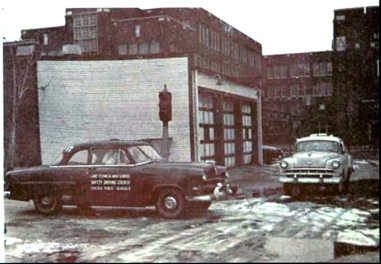
In 1936, Lane was selected to begin an experiment at driving instruction. There was a large outdoor driving course as well as an indoor driver education classroom where they used an old car cut off in front of the dash and behind the drivers seat. Shop students built the 30 wood dummy “practice cars” with dummy controls for the classroom. Traffic pictures were projected on a screen and students actions appeared on a lighted control board for the instructor to monitor.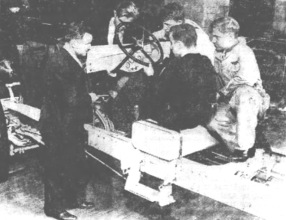
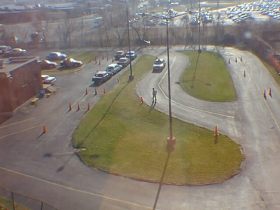

There was a greenhouse on the roof , a great sports stadium, a beautiful memorial garden and the “Shooting the Stars” statue, hidden from public view and dedicated to Lane’s war dead.
The focal point of the new building was of course the iconic clocktower. 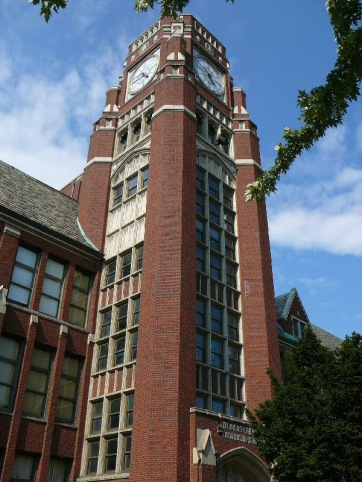
There was an “off limits” room up there in the tower, few have ever seen it or knew its existence. Urban legend says that students played cards there. If any reader knows any more of that “secret” room or even made access to it, please leave your comments below.
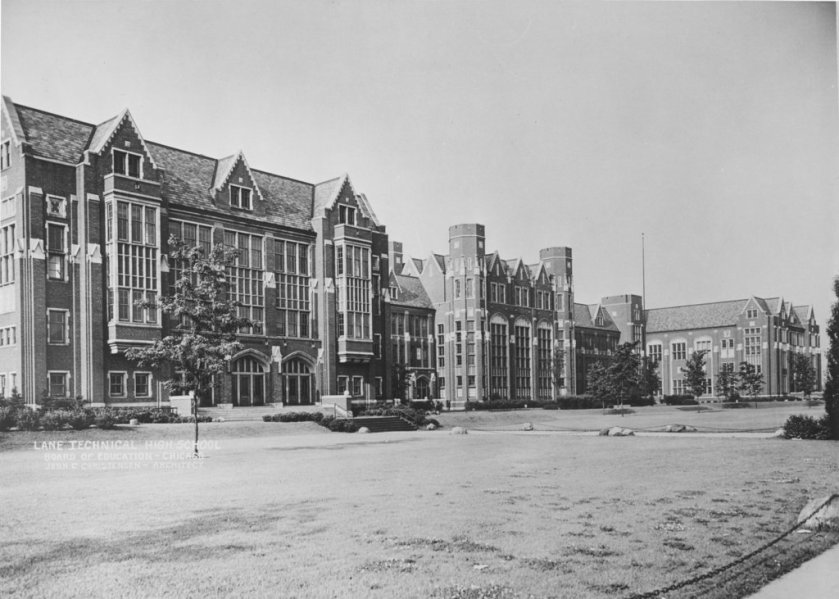 All space in the new building was used including the massive basement. There were a few classrooms and a bicycle storage room. There was a ROTC drill hall, a rifle range and headquarters. Rooms down there were prefixed with the number “0” such as 037.
All space in the new building was used including the massive basement. There were a few classrooms and a bicycle storage room. There was a ROTC drill hall, a rifle range and headquarters. Rooms down there were prefixed with the number “0” such as 037.

Early on there was a boat shop in the basement where students were building kayaks, canoes and row boats. The largest project built by students in 1941 was a government funded 32 foot long cabin cruiser weighing 10 tons. It was built in such a way that when completed it could be disassembled and removed from the basement shop.
For decades, thousands of blue collar tradesmen from electricians to iron workers to welders and plumbers learned their craft at Lane. They went into the industries that built Chicago and earned a good living. In the 1940’s the list of shops were impressive. Wood shop for freshmen, electric shop for sophomores, then choices in metalworking: including gas and electric welding, forge shop, foundry shop, Heat treating, pattern making, and aviation sheet metal. Then there was aviation shop, aviation electric shop, architecture shops, plastics shop, air-conditioning, automotive and automotive electric shops.
Wood shop for freshmen, electric shop for sophomores, then choices in metalworking: including gas and electric welding, forge shop, foundry shop, Heat treating, pattern making, and aviation sheet metal. Then there was aviation shop, aviation electric shop, architecture shops, plastics shop, air-conditioning, automotive and automotive electric shops. A very large print shop, composition shop and Linotype shop instilled hundreds of students to enter the printing trades. The print shops using flatbed letterpress and offset presses which produced the Lane Daily newspaper, a monthly Tech Prep, and the annual Arrowhead yearbook.
A very large print shop, composition shop and Linotype shop instilled hundreds of students to enter the printing trades. The print shops using flatbed letterpress and offset presses which produced the Lane Daily newspaper, a monthly Tech Prep, and the annual Arrowhead yearbook.
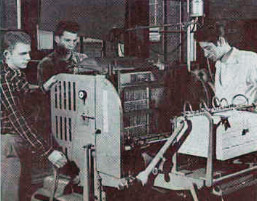
Some 24 technical classrooms included seven electrical, five auto, five foundry and welding, five machine shops, three graphic arts, nine woodworking and architectural wood, and twenty drafting rooms. Shop students made projects out of wood and metal that they could take home.
Many still exist and some make their way to Ebay. Students built the 300 wood and stone benches for the Lane Tech campus. The class of 1940 was one of the largest, with 2182 graduates.
And of course, in addition to the shops, there were traditional subjects in general science, biology, physics, chemistry, algebra, trigonometry, typing, English composition and literature, history and civics just to name a few.
ELEVATOR PASSES
Lane Tech was not all study. If you were a Freshman you might have been offered some great perks from upperclassmen. For a nominal fee you might have been offered or purchased an elevator pass. (There is indeed two elevators but neither available to able bodied students.) Back in my day there were other dubious offers for left handed drafting shoes or steam heated lockers. If you care to admit to a purchase of any of these, please leave a comment.
VOLKSWAGEN STORY
There is an undocumented urban legend that a group of Lane students somehow snuck a Volkswagen into the school. It was supposedly hauled up in pieces and reassembled in an upper floor hallway during the dark of night. If anyone can confirm this story or has additional details, please leave comments.
ADMISSIONS AND GIRLS
Lane adopted a closed admission policy in 1958 on the school’s 50th anniversary in which students must take a test and pass a certain benchmark in order to be offered admission. Lane is one of eleven selective enrollment schools in Chicago, a diverse school with students coming from different ethnicities and economic backgrounds.
In 1971 the Board of Education approved the recommendation to admit girls to Lane Tech, but this was not the first time Lane was coed. During summer sessions and evening classes at the old Lane on Sedgwick circa 1929, girls studied dressmaking, millinery and even aviation.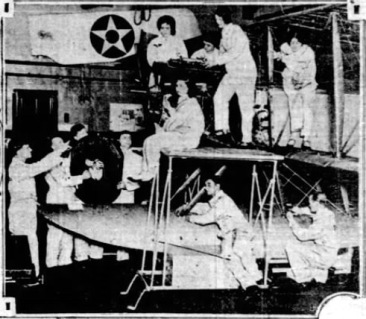
A NEW ERA
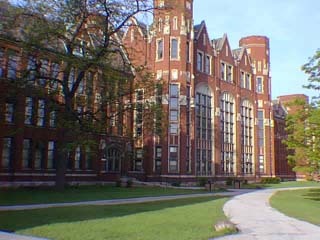 When “Lane Tech” became Lane Technical College Preparatory High School, a public 4-year selective enrollment magnet high school, the industrial shops and conventional drafting classes were closed. All the shops were removed and the rooms were repurposed to serve new technologies in a changing world. There is a Reading and Writing Computer Resource Lab, Apple Computer Lab, and a STEM wing complete with an aquaponics facility and two multi-purpose computer labs. The LTMaker Lab is equipped with laser cutters, 3D scanners, printers and carvers, vinyl cutters, and more.
When “Lane Tech” became Lane Technical College Preparatory High School, a public 4-year selective enrollment magnet high school, the industrial shops and conventional drafting classes were closed. All the shops were removed and the rooms were repurposed to serve new technologies in a changing world. There is a Reading and Writing Computer Resource Lab, Apple Computer Lab, and a STEM wing complete with an aquaponics facility and two multi-purpose computer labs. The LTMaker Lab is equipped with laser cutters, 3D scanners, printers and carvers, vinyl cutters, and more.
The technologically advanced class courses would amaze and please Albert Lane if he were alive today. There are a wide variety of computer science classes, Media Computation , Programming Web Development, Microarchitecture Logic Design, Android Development, Physical Computing Lab, Artificial Intelligence, Cyber Security 3-D animation, digital design, Digital Imaging, engineering design, Sound engineering, robotics and more.
Creative courses now include Photography, Creative Arts Studio, Printmaking, Sculpture, Contemporary Painting, Studio Drawing and Painting, Mixed Media Illustration , Independent Study Art , 3-D Design , 2-D and 3D design, Art History, Film Studies, Textiles, Fiber Art, Metalsmithing and more. In addition, Lane Tech offers over 100 other electives including many world languages such as Arabic and Latin. There are dozens of new extra-curricular activities and clubs for every interest. It is a vibrant and exciting place to learn. The old Lane Tech has been well reinvented to serve students of today.
ALUMNI
 Lane Graduates are found in every walk of life. Over its many decades, Lane has produced thousands of engineers, architects, researchers, authors, musicians, composers, singers, actors and actresses, radio TV performers, talk show hosts, news anchors, teachers, professors, police officers and firefighters, lawyers, businessmen and politicians.
Lane Graduates are found in every walk of life. Over its many decades, Lane has produced thousands of engineers, architects, researchers, authors, musicians, composers, singers, actors and actresses, radio TV performers, talk show hosts, news anchors, teachers, professors, police officers and firefighters, lawyers, businessmen and politicians.
Lane graduates have included Edgar Bergen the ventriloquist and radio performer best remembered best for creating Charlie McCarthy. The well known Chicago police officer and pioneering helicopter traffic reporter Leonard Baldy is a graduate. The school has taught a former governor of Illinois, a chief of staff to President Bill Clinton, a U.S. Navy admiral, a Professor Emeritus of Columbia College Chicago and a professor at the School of the Art Institute of Chicago. Graduates from its music program have become members of the Chicago Symphony Orchestra. There has been a classical violinist, a singer and guitarist who co-founded The Buckinghams, singer, songwriter and actor Frankie Laine (born Francesco Paolo LoVecchio). One source suggests that Laine’s stage name was taken from the school.
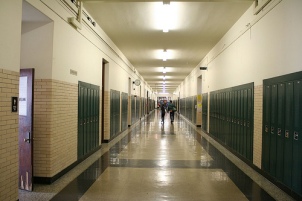 Graduates have gone on to become major league players in the NFL, AFL, NBA, and more. There has been a former manager of the Chicago Cubs and a former General Manager of the Los Angeles Dodgers. There has been a sports broadcaster for the Milwaukee Braves and Green Bay Packers, a head coach at Bradley, Drake and Kansas State. Teams with Lane graduates have included the Chicago Cubs, Chicago White Sox, Chicago Cardinals football, the Cleveland Indians. Boston Red Sox, St. Louis Browns, St. Louis Cardinals, St. Louis Rams, Philadelphia Phillies and others. Lane graduates have competed in the Olympics. including Johnny Weissmuller a five-time Olympic gold medal-winning swimmer who later became an actor, and best known for his portrayal of Tarzan in the MGM film series 1932–42
Graduates have gone on to become major league players in the NFL, AFL, NBA, and more. There has been a former manager of the Chicago Cubs and a former General Manager of the Los Angeles Dodgers. There has been a sports broadcaster for the Milwaukee Braves and Green Bay Packers, a head coach at Bradley, Drake and Kansas State. Teams with Lane graduates have included the Chicago Cubs, Chicago White Sox, Chicago Cardinals football, the Cleveland Indians. Boston Red Sox, St. Louis Browns, St. Louis Cardinals, St. Louis Rams, Philadelphia Phillies and others. Lane graduates have competed in the Olympics. including Johnny Weissmuller a five-time Olympic gold medal-winning swimmer who later became an actor, and best known for his portrayal of Tarzan in the MGM film series 1932–42
A SCHOOL THAT EXCELS
 As of 2018, Lane had a 94% graduation rate. More than 90 percent of students earn college degrees in architecture, engineering, medicine, mathematics, science, journalism, accounting, music, art, and teaching. More Ph.D’s have graduated from Lane than any other high school in the nation.
As of 2018, Lane had a 94% graduation rate. More than 90 percent of students earn college degrees in architecture, engineering, medicine, mathematics, science, journalism, accounting, music, art, and teaching. More Ph.D’s have graduated from Lane than any other high school in the nation.
I am incredibly proud to be a graduate of Lane Tech high school, class of June 1962. My four years were some of the best years of my life. The teachers were dedicated and inspiring. The technical skills learned propelled me directly into the engineering department of a major machine tool manufacturer, while still finishing my senior year. Even though I am now retired in Arizona, I often encounter others in my travels who have proudly graduated Lane.
And if you, the reader, attended Lane, I would love to hear your story. Please add your comments, memories and class year below!
AND FINALLY…
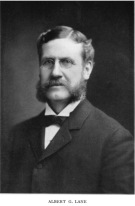
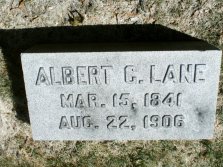 Albert Grannis Lane died on August 22, 1906 at his residence 430 west Adams, hastened by intense heat and overwork, just some six months after his mother’ death. His wife was quoted as saying, “He was all that a son could be, he was all that a church member could be, and you know what he was as a citizen and educator”.
Albert Grannis Lane died on August 22, 1906 at his residence 430 west Adams, hastened by intense heat and overwork, just some six months after his mother’ death. His wife was quoted as saying, “He was all that a son could be, he was all that a church member could be, and you know what he was as a citizen and educator”. 
His funeral was at the Centenary Methodist Episcopal Church on West Monroe near Morgan. Albert and his family are all buried in Rosehill cemetery, 5800 N Ravenswood on Chicago’s far north side.. He did not live long enough to see how he changed and continues to change the lives of hundreds of thousands of Chicago’s youth. His impressive legacy continues to this day.
Well done Albert! Go Lane Go!
For an additional Lane story, read “ SSSSSH This is a Library!” 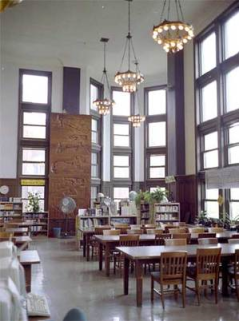
And for the story of Officer Baldy read “ Flying with the Angels”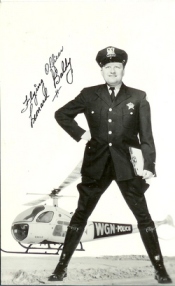
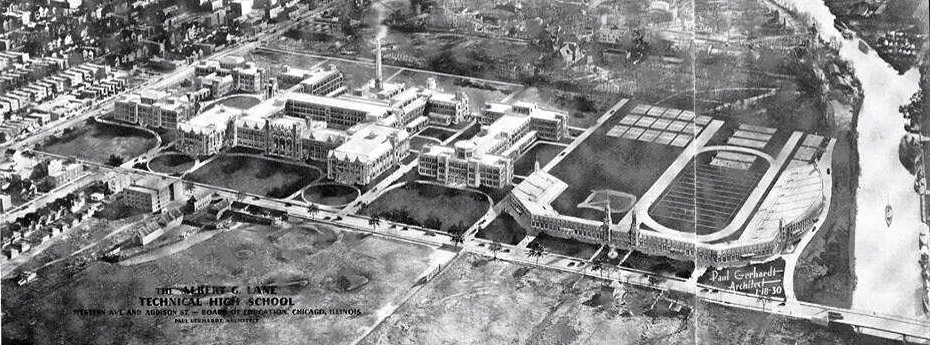



1975 graduate, and played on the baseball team. Great memories of my time at LTHS and will never forget the news media who were there on the first day female students entered the halls.
LikeLiked by 1 person
Interesting historical facts!
LikeLike
i was in the last all male class
LikeLike
sad. that all we knew. Never knew much about girls until college
LikeLike
Haha – I was in Lane’s first class of females to graduate, 1974. One random morning during the hectic change of classes, some boy grabbed my butt. With great determination, I kicked the closest random boy and said, “This is for all of you from all of us.”
LikeLike
Barton:
Sorry, that is actually kind of funny and I was the same. I graduated William P. Gray grade school, went on to Lane Tech, and graduated January 1967 (last January graduating class). Not knowing what I wanted to do, I went to work as a laborer/tuckpointer with my dad on the downtown buildings 5 or so stories up.
Our prom was held at the Edgewater Beach hotel. I had the prettiest (according to my classmates) young lady with me who I met at church several years earlier. She taught me how to behave around young women. It was a great prom and I doubled with another guy who had his dad’s Cadillac sedan (a boat). We had dinner at the London House. Gene Krupa was on the drums there (a new experience for me [never knew he was famous]). Darrell Splitoff (?) was our class president.
In April of 1968, I left for Marine boot camp. I met my future wife in 68 and married her after I was discharged several years later. From that geeky kid in high school, I had changed. Not quite sure how she tolerated me. I did learn what it was like to be around women quickly. While I was a Sergeant when I was discharged, she out ranked me.
In the early eighties I did receive a Masters degree from Loyola and stopped short of a PhD in Economics . Too many children and I was needed at home.
I liked the stories here. A lot of history . . .
LikeLike
I didn’t attend Lane, but I took driver’s ed there. Attended a few dances and football games.
Class of 1973, Alvernia H.S. Great backstory and loved reading it. Thanks
LikeLike
thanks for writing
LikeLike
I am a 1966 January graduate!
LikeLike
you have good taste in high schools
LikeLike
What a great history of Lane Tech. Graduated in 1946. Great memories, played football.
LikeLike
Not Ed Swarm—Ed Swanson
LikeLike
Great history of Lane Tech! Graduated in 1946 and played football with a great bunch of guys.
LikeLike
1960 graduate. Lane experiences in chorus, in concert band, in symphony orchestra, and in harmony and orchestration classes opened lifelong musical interest. High academic standards encouraged me in obtaining liberal arts undergraduate degree plus masters and doctoral degrees before becoming a professional educator for 37 years.
LikeLike
This is Raymond Van Dyke, Class of 1975. Thank you for the absolutely wonderful history of the land that became Lane. Looking at the comments, it amazes me that there are so many and different perspectives, and people of many walks of life – but we are all one in Lane. Go Lane Go! At Lane, I wrote code long before Microsoft – the Lane Computer Club. Many years later I got a Masters in Computer Science. Lane gave me a wonderful foundation for life, and even got me a job later – as a young patent attorney on Park Avenue in NYC (a partner in a law firm there thought highly of Lane). I remember the “controversy” over the admission of girls in Fall 1971. I also remember having crushes on some them! So many memories and fabulous teachers, Pedre, Goldman and Heinan for Math, being the Lane Math team captain, and the last Slide Rule Club President! The slide rule badge is on my Lane sweater! Being math & science, so much was unknown to me then: art, music and language, which I devoured later. Minor in Classical Greek. I distinctly remember the majesty and magnitude of Lane that first day, like Harry at Hogwarts, agog that this was MY school. I have been a patent attorney for over 30 years, and am also an adjunct professor in technology and law. The loss of the shops at Lane is sad. I enjoyed woodworking and print shop. Hands-on training has immense value. The Seventies were a tumultuous time (Watergate, Vietnam, cold war) for us, but Lane is a constant in any time period for its students. I am a very proud graduate of the best preparatory high school in the world, and wish all the best to all of my classmates in the Great Class of 1975 and in all other years! We are one.
LikeLike
Class of 1974. First Coed in the Addison building. Remembering the print shop classes as my favorite.
LikeLike
Class of 1979
LikeLike
Not many high schoolers can say they played the national anthem at a Chicago Cubs baseball game (1984), but I did as a member of the Lane Tech Marching Band. I was a student at Lane Tech when we celebrated our 75th anniversary (1983) and our 50th anniversary at Addison and Western (1984). Go Lane Go!
LikeLike
Lots of memories. Coming from a small elementary school (Talcott) and being one of 3 selected to attend and glad I could do it with my best friend Ramon. We did the walk to Wrigley in 83 as freshman. Graduated in 87. Beig part of a renegade type social group. I did as much shop as possible. It taught me a lot. Don’t think it was right to take them all out without giving the younger generation a choice on their future life. If they ever try to bring them back and need an advocate than I am on board. Having been in a certain kind of social group we did a lot of pranks. Most memorable was senior year and being the group that we were, we parked our cars in a giant circle in the lot and had a cookout. Needless to say the fire dept and police were called. Most people remember us from our vehicles. I was the kid with the blue Camaro with a green Z28 door. my buddy Ted had the Dragon wagon while Bill had the 77 Gold Thunderbird. Bob had the Big Blue Van and my other buddy Ed had the Flame Red Nova with flared out fenders. Anyone reading this from my time period will go ” Oh my god yes, I remember them”. Definalely found memories. Plus having spent a lot of times roaming those great halls and 3 years in autoshop, I was one of those who wondered into the basement since an entrance to it was right by shop. Also getting a little turned around in that massive building I did get a chance to go to the clock tower. I could go on for ever about Lane but thats for another time. I am truly surprised that more students from my time period don’t post much. But if anyone reading this than please give a shout out or at least a thumbs up.
LikeLike
CHARLES GARRETT. I WAS A CORNET PLAYER IN THE MUSIC DEPARTMENT. CAPT. HUFF’S ROTC MARCHING BAND & THE CONCERT BAND. I ATTENDED IN 1945/46/& 47. WONDERFUL YEARS & MEMORIES. I HAVE NICE BAND PICTURES IN MY YEAR BOOKS. I’M COMING UP ON 92 BUT REMEMBER IT ALL. THANKS CHUCK
PS. I WONDER WHO ALL IS LEFT?
LikeLike
Remember practicing football behind the stadium and watching the Riverview roller coaster structures being torn down back in 1967.. graduated in 1969.
LikeLike
I had to do some digging to find out who wrote the the fantabulous story! We missed you at the recent 60th class reunion, Barry! I hope you can make it to the next one.
LikeLike
I graduated from Lane in 68. My 4yr locker partner was Ken Shubert whom I still call a good friend. My father in law graduated in 38, daughter in 2000 and son in 2004. Go Lane Go
LikeLike
JUST DID A STORY ABOUT THE LANE LIBRARY. ENJOY
https://chicagoandcookcountycemeteries.com/2020/02/17/shhush-this-is-a-library/
LikeLike
My girl friends and I went to Riverview a lot. We took the Addison st. bus there from 6000 west. Great fun ! This was back in the fifties.
LikeLike
GREAT article and memory about Lane Tech. I’m 78 years old now and still have the Lane Indian and letters L A N E from my gold sweater. I also have the same (as pictured in your article) wooden plague I made in wood shop with Mr. Connolly and the words Lane Tech on it that I made in Foundry shop with Mr. Dix. Holy moly what a flashback of memory.
LikeLike
I’m 77 years old and made the same wooden plaque. I assume everybody in Mr. Connolly’s shop made the same. I couldn’t afford the Lane sweater at the time. My father had just died. I appreciate the memories in this thread.
LikeLike
Actually Robert, my Lane sweater was 2nd hand as we couldn’t afford a new one either. Did you have Connolly’s wood shop class too? What other classes/teaches do you remember? I still have my course book. What neighborhood were you living in? Lots of great memories from that time.
LikeLike
I lived in the Avondale neighborhood where I attended all 8 years of elementary school then we moved up Cicero to the Austin district during my softmore year at Lane. That place turned into a real hell hole after I graduated and left for Viet Nam with the Air Force. I really think that Chicago is a lousy place to grow up. I now live in the green foothills of the Smoky Mountains.
LikeLike